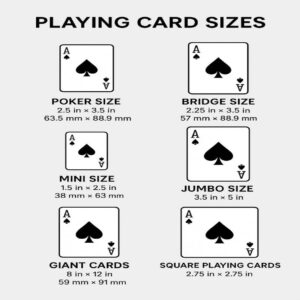When it comes to playing cards, size does matter. Whether you’re a magician, a card game enthusiast, or simply someone who enjoys the occasional game of solitaire, understanding the dimensions of playing cards can enhance your experience. In this comprehensive guide, we’ll delve into the various sizes of playing cards, their measurements, and why these dimensions are important. From standard sizes to specialty designs, knowing your card dimensions can elevate your gameplay, improve your shuffling technique, and even prolong the life of your deck.
Understanding Playing Card Dimensions
Playing cards have been a staple in games and magic tricks for centuries. However, not all decks are created equal. The dimensions of playing cards can vary based on their intended use, the region where they’re manufactured, and personal preferences. By understanding these variations, you can choose the right card size for your needs and enhance your gaming experience.
Historical Perspective on Card Sizes
The history of playing cards dates back centuries, with origins in Asia before spreading to Europe. Early cards were hand-painted and varied in size considerably. The standardization of card sizes only began in the late 19th century, driven by the demands of industrial production and the burgeoning popularity of card games. Understanding this evolution helps appreciate why certain sizes became standardized and widely adopted.
Standard Playing Card Dimensions
The most common size for playing cards is the “poker size.” This size is widely used in casinos and home games alike. A standard poker card measures 2.5 inches in width and 3.5 inches in height. This size is ideal for shuffling and dealing, making it a favorite among card players. The uniformity of poker-sized cards allows for consistency in gameplay, ensuring that players can smoothly transition between different games and settings without adjusting to new card dimensions.
Bridge Size vs. Poker Size
While poker size is popular, there’s another common size known as “bridge size.” Bridge cards are slightly narrower, measuring 2.25 inches by 3.5 inches. This size is preferred in bridge games, hence the name, as well as for those with smaller hands or for games that require more cards to be held at once. The narrower design of bridge cards facilitates easier handling and shuffling, particularly in games where players must manage large hands, making them a practical choice for diverse gaming scenarios.
Regional Variations
In addition to poker and bridge sizes, playing card dimensions can also vary depending on the region. For instance, in Europe, the standard size might differ slightly due to traditional manufacturing practices. It’s not uncommon to find cards that are a bit longer or wider than their American counterparts. These regional variations reflect cultural preferences and historical influences, offering a glimpse into how different societies approach card gaming.
Influence of Material and Manufacturing Techniques
The material and manufacturing techniques used to produce playing cards can also impact their dimensions. Cards made from high-quality cardstock or plastic may have slightly different thicknesses, affecting their feel and durability. Advanced printing and cutting technologies allow for precise dimension control, ensuring that each card in a deck is consistent in size and shape, a crucial factor in maintaining fairness and consistency in gameplay.
Specialty Playing Card Sizes

Beyond the standard poker and bridge sizes, there are numerous specialty playing card sizes designed for unique purposes or to cater to specific audiences. These specialty sizes can add an element of novelty to your games, making them more engaging and memorable.
Jumbo and Giant Cards
For those looking to make a big impression, jumbo and giant playing cards are available. Jumbo cards typically measure around 4 inches by 6 inches, while giant cards can be much larger. These oversized cards are often used for magic tricks, educational purposes, or simply as a novelty. Their large size makes them easy to see, which is beneficial for audiences during performances or for players with visual impairments.
Miniature Cards
On the opposite end of the spectrum, miniature playing cards provide a compact option. These cards are usually about 1.5 inches by 2 inches, making them easy to transport and store. They’re perfect for travel games or for those who enjoy collecting unique card decks. Their small size makes them an excellent choice for limited spaces, such as on airplanes or in small living areas, where full-sized decks may be cumbersome.
Novelty and Custom Sizes
In the world of playing cards, novelty and custom sizes are also popular. These cards can be cut into unique shapes or printed in unconventional sizes. Whether it’s heart-shaped cards for Valentine’s Day or a custom size for a promotional event, the possibilities are endless. Custom cards offer a unique branding opportunity for businesses or a personalized touch for special occasions, making them a versatile choice for both individual and corporate use.
Specialty Cards for Professional Use
In addition to novelty and custom cards, there are specialty sizes designed for professional use, such as those used in magic shows or cardistry. These cards may have unique dimensions or features that enhance their performance qualities, such as increased flexibility or special coatings to facilitate sleight of hand. For professionals, choosing the right card size and features can significantly impact the quality of their performances.
The Importance of Playing Card Dimensions
Understanding the dimensions of playing cards goes beyond mere aesthetics. The size of your cards can impact gameplay, shuffling, and even the durability of your deck. Selecting the appropriate card size can enhance your overall playing experience and ensure that your cards remain in good condition for as long as possible.
Gameplay Considerations
The size of playing cards can influence how a game is played. For instance, smaller cards are easier to handle for games that require players to hold many cards at once, like rummy or bridge. Conversely, larger cards can be beneficial for games where visibility is key, such as magic tricks or educational activities. The right card size can facilitate smoother gameplay, reducing the likelihood of mistakes or disruptions during a game.
Shuffling and Dealing
Shuffling and dealing are integral parts of any card game. A deck that’s too large or too small can make these tasks cumbersome. Poker-sized cards strike a balance, providing enough surface area for effective shuffling while remaining easy to deal. Proper shuffling ensures that the game remains fair and unpredictable, a crucial element in maintaining the integrity of any card game.
Durability and Storage
The dimensions of playing cards can also affect their durability and how they’re stored. Larger cards may be more prone to bending or damage, especially when shuffled frequently. Additionally, storing oversized decks can be challenging if you don’t have the right containers. Proper storage solutions, such as card boxes or cases, can help protect your cards from damage and ensure they remain in good condition over time.
Ergonomics and User Comfort
The ergonomics of card dimensions can greatly affect user comfort, particularly during extended play sessions. Players with smaller hands may find larger cards difficult to handle, while those with larger hands may prefer a more substantial card. Choosing a size that fits comfortably in your hand can reduce fatigue and enhance your enjoyment of the game.
Choosing the Right Playing Card Size
| Type | Dimensions | Best For |
|---|---|---|
| Poker | 2.5″ × 3.5″ | Most games, casinos |
| Bridge | 2.25″ × 3.5″ | Games requiring many cards in hand |
| Mini | 1.5″ × 2″ | Travel, novelty |
| Jumbo | 4″ × 6″ | Magic shows, visibility needs |
Selecting the right playing card size depends on a variety of factors, including the type of game you’re playing, personal preferences, and any specific needs you may have. By considering these factors, you can ensure that your card-playing experience is both enjoyable and efficient.
Consider the Game
Think about the games you play most often. If you frequently play poker or other casino-style games, sticking with the standard poker size is a safe bet. For bridge players, the bridge size is a natural choice. Additionally, consider any specific requirements of your favorite games, such as the need for a large number of cards in hand or the importance of clear visibility for all players.
Personal Preference
Ultimately, personal preference plays a significant role in choosing the right playing card dimensions. Some players prefer the feel of larger cards, while others find smaller cards more comfortable to handle. Experimenting with different sizes can help you determine which feels best for you, allowing you to tailor your card-playing experience to your individual tastes and needs.
Special Needs
If you have specific needs, such as requiring cards that are easy to see or handle, consider specialty sizes. For example, jumbo cards are great for those with visual impairments, while miniature cards are perfect for travel. Assessing your unique requirements can help you choose a card size that enhances your playing experience and accommodates any limitations you may have.
Professional Considerations
For professional card players or magicians, the choice of card size can be particularly important. The right dimensions can enhance performance, facilitate complex maneuvers, and ensure that tricks are executed smoothly. Professionals should consider the demands of their specific field when selecting card sizes, ensuring that their choice aligns with their needs and enhances their craft.
Conclusion
Playing card dimensions may seem like a minor detail, but they can have a significant impact on your gaming experience. By understanding the various sizes and their benefits, you can choose the right deck for your needs, ensuring that every game is as enjoyable as possible. The right dimensions can enhance your gameplay, improve your shuffling technique, and ensure your cards last longer.
Whether you’re a seasoned card player or just starting, knowing the ins and outs of playing card measurements will help you make informed decisions and enhance your love for the game. So next time you’re in the market for a new deck, remember this guide to find the perfect fit for your card-playing adventures. With the right dimensions in hand, you’re ready to enjoy countless hours of engaging gameplay, whether at home, at a casino, or on the go.
Also read: Types of Web Development Services to Build Your Digital Presence
